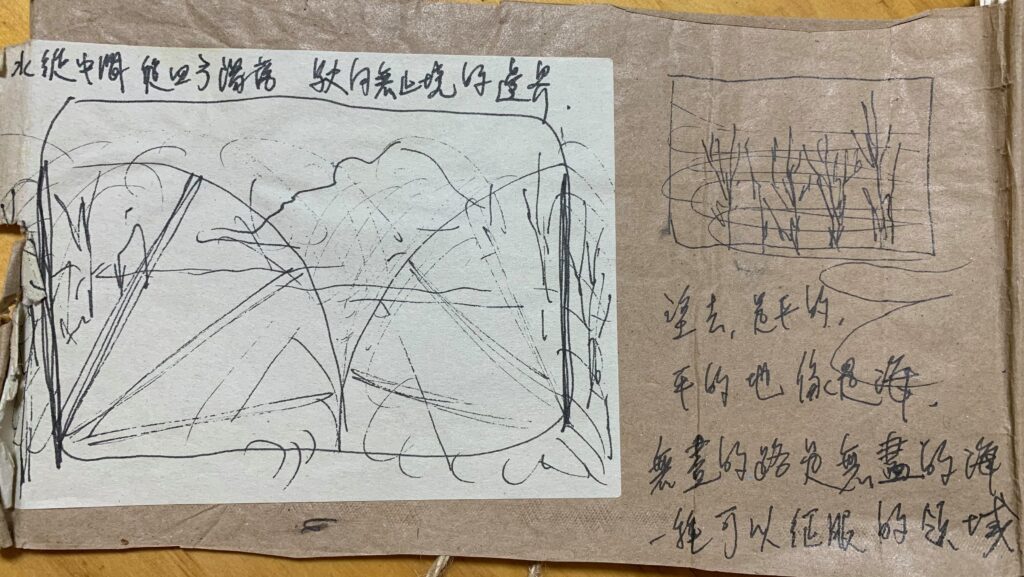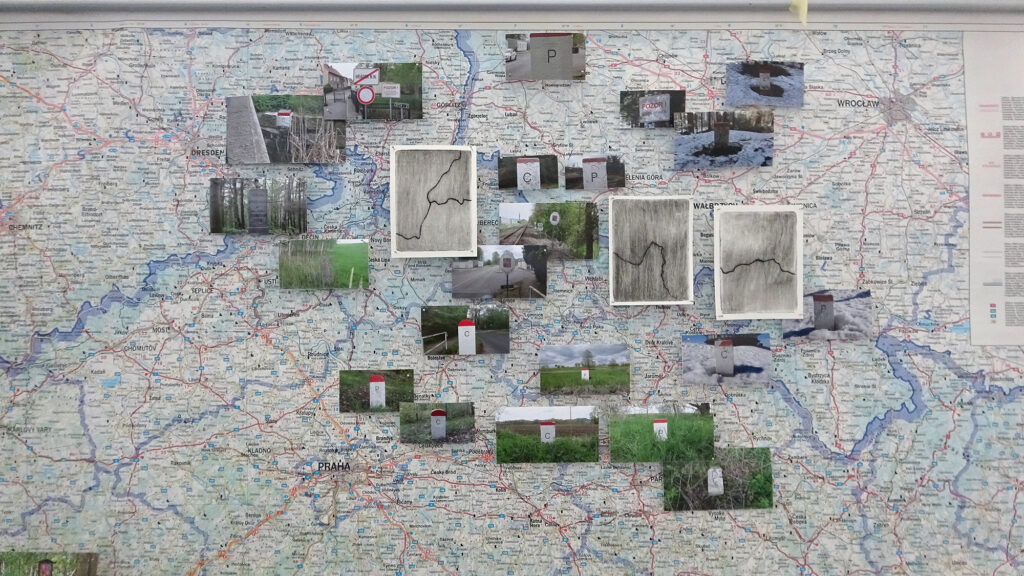
飄浮邊界-邊界之間
Floating Boundary – Between Border
6個月行為計畫,2019年執行於捷克國界。
錄像、版畫、文件,依場地而定。
展出於水谷藝術,臺灣,臺北,2019。
Performance project for 6 months, happened in Borders in Czech in 2019.
Video, print, document, dimensions variable.
Exhibit in Waley Art, Taipei, Taiwan, 2019.


此計畫發生於捷克國土邊界,邀請當地朋友在邊界之間進行一場遊戲。討論邊界於戰後從形而下轉換成形而上的存在變遷。
連結出生於島嶼國家的身體移動經驗差異,島嶼到大陸、大陸到大陸,面對歐陸綿延不絕的土地,透過螢幕中的Goole Map初訪邊界,並以Open Call的形式拜訪居住、工作、求學於邊界的朋友,考察位於自然、城市、村落的邊界樣貌,與當地人交談邊界歷史,邀請朋友在邊界進行一場遊戲。
計畫前後拜訪了捷克北方的斯涅日卡山(Sněžka)山頂周邊的兩處邊界、哈拉霍夫(Harrachov)山區雪場左方的森林、利貝雷茨(Liberec)區域北邊七個邊界城鎮與山;西方的普列什(Pleš)小鎮、東方奧斯特拉瓦(Ostrava) 市區與波蘭的切申(Cieszyn)的交界,最後是南方的鐵礦鎮(Železná Ruda)。
This project took place on the borders of the Czech Republic, inviting local friends to play a game between the borders. Discuss the existential changes of the boundary from the metaphysical to the upper after the war..
Connecting the difference of body movement experience from island countries, from island to continent, from continent to continent, facing the endless land of the continent, have a first visit to the border through the Google Map on the screen. Through the Open-Call, Hsu visit friends who live, work, and study near the border, investigating the views of borders located in nature, cities and villages, talk with locals about the history of the border. After that, Hsu invite friends to play a game between border.
During the project, Hsu visited two borders around the top of mountain Sněžka in northern Czech Republic, the forest on the left of the Harrachov mountain ski resort, seven towns or mountains in the north of Liberec region; the small town of Pleš in the west, the city of Ostrava in the east in Czech Republic but also the city of Cieszyn in Poland, and finally the Iron Ore Town (Železná Ruda) in the south.

邊界,我特別關注自然場域的邊界劃分,除了透過溪流劃分格外顯著,雪地、森林、草原等地質時常沒有明確的邊界標示,對於身為外國人的我而言,這些場域同質而自由,對於當地人而言卻是異質而侷限。在同一片雪地上,人類透過文化、政治、經濟劃分彼此界限,二戰前後,邊界從形而下轉換成形而上的存在。九零後出生的年輕人處於申根開放的機制,形而上的邊界意識一代又一代地削弱,恰恰反應邊界當今的模糊性。
現地行為以邊界中線為背景與朋友進行遊戲,遊戲內容包含乒乓球、羽毛球、排球、氈黏球等,將邊界想像成是『球網』-區分你我的基準,隨著球與玩具來回於邊界兩側,遊戲者們想像著網子的大略位置,在身體移動的過程,那張『想像的網』不斷浮動,一如當今年輕世代對於邊界的意識。
Hsu pay special attention to the boundary division of natural fields. Except for the division by streams, boundaries with the geology of snowfields, forests, grasslands, etc. is often not clearly marked. For me, as a foreigner, these fields are homogeneous and free, but heterogeneous and limited to the locals.
On the same snowfield, human have being divide through culture, politics, and economy with boundaries. After World War II, the idea of boundaries changed from physical to metaphysical. Young people born after the 1990s are in the Schengen open situation, and their metaphysical boundary awareness has weakened from generation to generation, which precisely response to the current ambiguity of the boundary.
The performance is located on the center line of the boundary, playing games with friends. Games includes table tennis, badminton, volleyball, sticky balls, etc., imagine the boundary as a net, a benchmark for distinguishing you and me. As the ball and toy go back and forth between both sides of the border, imagine the approximate position of the net. As the body moves, the “imaginary net” keeps floating, just like the consciousness of the young generation about the border.

呼應前述以Google Map的Room In放大功能初訪邊界,透過螢幕網頁,不斷穿越於數位地圖的各種尺度,隨著線條粗細變化與實景交錯,反覆暗示邊界的曖昧性。於是,我開始搜集不同比例的紙本捷克地圖,於現地拍攝後,從紙本地圖擷取拍攝的邊界線,以手繪拷貝並轉刻至金屬鋼板,再以版畫方式轉印,透過一層層手工轉印,從紙本地圖、手繪拷貝、鋼板復刻、油墨轉印的過程,重述邊界的曖昧不明。
展場中,我以懸吊的筆電播放現地行為紀錄,以不穩定與搖擺的狀態,呼應邊界的模糊空間。筆電的直線排列堆疊出中線的邊界,觀眾得以透過穿越電腦進行邊界的穿越與觀看。右方牆面陳列行為發生的五個邊界線,分別是鋼板本身與轉印的版畫文件。
Echoing the aforementioned Google Map\’s room in function, through the screen, it constantly traverses the various scales of the digital map. As the line thickness changes and the real scene is staggered, it repeatedly implies the ambiguity of the boundary.
Hsu began to collect different scales of Czech paper maps. After shooting on site, extracted the boundary lines from the paper maps, copied them by hand and engraved them on a metal steel plate, and then transferred them with prints. Using layers of handwork. Through the process of paper map, hand-painted copy, steel plate engraving, and ink transfer, retelling the ambiguity of the boundary.
In the exhibition , Hsu used a suspended laptop to play records of performances, echoing the blurred space of the boundary in an unstable and swaying state. The linear arrangement of the notebooks reproduced the boundary of the center line. The audience can cross and watch the boundary by crossing the computer. The five boundary lines of the performances were placed on the wall on the right, which are the steel plates and the printed files.







計畫行為者 Project Performer|
Tomas Vydra, Karolína Vydrová, Jindřiška Lidická, Kuba, Tomas Honz, Aleš Hnízdil, Anička Veselá, Barbora Pánková, Lenka Dřevjaná, Kateřina Hronová, Magda Benešová, Veronika Libánská, Maurice Wirtz, Peter Oberloher, Jonathan Pielmeier, Sophie Dutiné, Hsu Yi-Ting, Huang Shao-Hsuan
協助 Assist|Tomas Vydra, Dušan Zahoranský, Aleš Hnízdil
拍攝 Photographer|許懿婷 Hsu Yi-Ting
